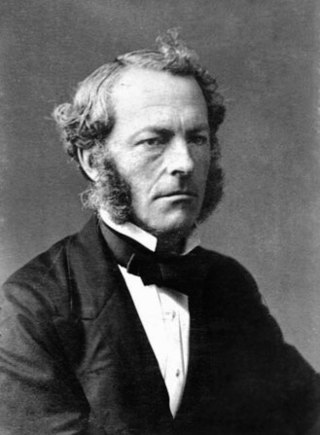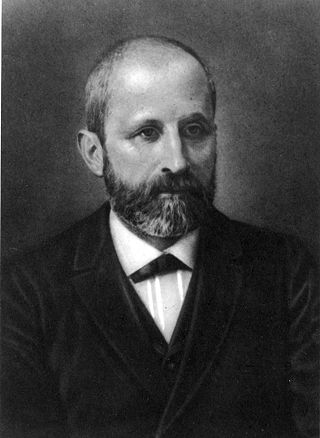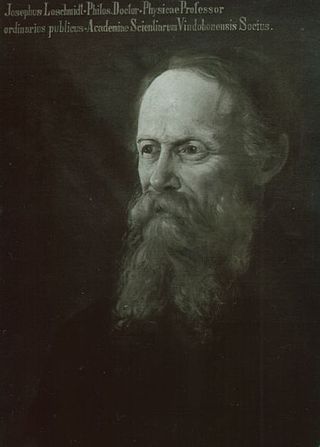Related Research Articles

John William Strutt, 3rd Baron Rayleigh, was a British mathematician and physicist who made extensive contributions to science. He spent all of his academic career at the University of Cambridge. Among many honours, he received the 1904 Nobel Prize in Physics "for his investigations of the densities of the most important gases and for his discovery of argon in connection with these studies." He served as president of the Royal Society from 1905 to 1908 and as chancellor of the University of Cambridge from 1908 to 1919.

Sir George Gabriel Stokes, 1st Baronet, was an Irish physicist and mathematician. Born in County Sligo, Ireland, Stokes spent all of his career at the University of Cambridge, where he was the Lucasian Professor of Mathematics from 1849 until his death in 1903. As a physicist, Stokes made seminal contributions to fluid mechanics, including the Navier–Stokes equations; and to physical optics, with notable works on polarization and fluorescence. As a mathematician, he popularised "Stokes' theorem" in vector calculus and contributed to the theory of asymptotic expansions. Stokes, along with Felix Hoppe-Seyler, first demonstrated the oxygen transport function of haemoglobin, and showed colour changes produced by the aeration of haemoglobin solutions.

Johannes Friedrich Miescher was a Swiss physician and biologist. He was the first scientist to isolate nucleic acid in 1869. He also identified protamine and made several other discoveries.

Ludwig Karl Martin Leonhard Albrecht Kossel was a German biochemist and pioneer in the study of genetics. He was awarded the Nobel Prize for Physiology or Medicine in 1910 for his work in determining the chemical composition of nucleic acids, the genetic substance of biological cells.
The year 1825 science and technology involved some significant events, listed below.
The year 1835 in science and technology involved some significant events, listed below.
The year 1842 in science and technology involved some significant events, listed below.
The year 1874 in science and technology involved some significant events, listed below.
The year 1895 in science and technology involved some significant events, listed below.
The year 1884 in science and technology involved some significant events, listed below.
The year 1873 in science and technology involved some significant events, listed below.
The year 1795 in science and technology involved some significant events.

The year 1801 in science and technology involved some significant events, listed below.
The year 1869 in science and technology involved some significant events, listed below.
The year 1846 in science and technology involved some significant events, listed below.

Johann Josef Loschmidt, who mostly called himself Josef Loschmidt, was a notable Austrian scientist who performed ground-breaking work in chemistry, physics, and crystal forms.

Ernst Felix Immanuel Hoppe-Seyler was a German physiologist and chemist, and the principal founder of the disciplines of biochemistry and molecular biology. He had discovered Yeast nucleic acid which is now called RNA in his attempts to follow up and confirm Miescher's results by repeating parts of Miescher's experiments

Maxwell’s thermodynamic surface is an 1874 sculpture made by Scottish physicist James Clerk Maxwell (1831–1879). This model provides a three-dimensional space of the various states of a fictitious substance with water-like properties. This plot has coordinates volume (x), entropy (y), and energy (z). It was based on the American scientist Josiah Willard Gibbs’ graphical thermodynamics papers of 1873. The model, in Maxwell's words, allowed "the principal features of known substances [to] be represented on a convenient scale."

The Seyler family is a Swiss family, originally a patrician family from Liestal near Basel. Family members served as councillors and Schultheißen of Liestal from the 15th century, later also as members of the Grand Council of Basel. A Hamburg branch descended from the banker and renowned theatre director Abel Seyler became by marriage a part of the Berenberg banking dynasty, co-owners of Berenberg Bank and part of Hamburg's ruling class of Hanseaten.
Montague Andrew Elijah Redgrave was an English-American game designer who bridged the gap between table Bagatelle and Pinball through his popular "Parlor Table Bagatelle" game. The game was first released around 1871 and possibly went on to influence the creation of the Caille Bros. "Log Cabin".
References
- ↑ Airy, G.B. (1871). "On the Supposed Alteration in the Amount of Astronomical Aberration of Light, Produced by the Passage of the Light through a Considerable Thickness of Refracting Medium". Proceedings of the Royal Society . 20 (130–138): 35–39. Bibcode:1871RSPS...20...35A. doi: 10.1098/rspl.1871.0011 . Retrieved 2015-01-03.
- ↑ Leff, Harvey S.; Rex, Andrew F., eds. (2002). Maxwell's Demon 2: Entropy, Classical and Quantum Information, Computing. CRC Press. p. 370. ISBN 978-0-7503-0759-8.
- ↑ Gavroglu, Kostas (2004). "Strutt, John William, third Baron Rayleigh (1842–1919)" . Oxford Dictionary of National Biography (online ed.). Oxford University Press. doi:10.1093/ref:odnb/36359 . Retrieved 2011-11-03.(Subscription or UK public library membership required.)
- ↑ Hoppe-Seyler, F. (1871). "Das Hämatin". Tübinger Med-Chem Untersuch. 4: 523–33.
- ↑ Trendelenburg, F (1871). "Beiträge zu den Operationen an den Luftwegen" [Contributions to airways surgery]. Archiv für Klinische Chirurgie (in German). 12: 112–33.
- ↑ Hargrave, R. (1934). "Endotraheal Anesthesia in Surgery of the Head and Neck". Canadian Medical Association Journal . 30 (6): 633–7. PMC 403396 . PMID 20319535.
- ↑ Bain, J. A.; Spoerel, W. E. (1964). "Observation on the use of cuffed tracheqstomy tubes (with particular reference to the james tube)". Canadian Anaesthetists' Society Journal. 11 (6): 598–608. doi: 10.1007/BF03004104 . PMID 14232175.
- ↑ Wawersik, Juergen (1991). "History of Anesthesia in Germany". Journal of Clinical Anesthesia. 3 (3): 235–44. doi:10.1016/0952-8180(91)90167-L. PMID 1878238.
- ↑ Miescher, Friedrich (1871). "Ueber die chemische Zusammensetzung der Eiterzellen" (On the chemical composition of pus cells). Medicinisch-chemische Untersuchungen4:441–460. From p. 456: "Ich habe mich daher später mit meinen Versuchen an die ganzen Kerne gehalten, die Trennung der Körper, die ich einstweilen ohne weiteres Präjudiz als lösliches und unlösliches Nuclein bezeichnen will, einem günstigeren Material überlassend." ("Therefore, in my experiments I subsequently limited myself to the whole nucleus, leaving to a more favorable material the separation of the substances, that for the present, without further prejudice, I will designate as soluble and insoluble nuclear material ('Nuclein').")
- ↑ Wilson, J. G.; Fiske, J., eds. (1900). . Appletons' Cyclopædia of American Biography . New York: D. Appleton.
- ↑ "Internet Pinball Machine Database: M. Redgrave Bagatelle Company '1871 Redgrave Parlor Bagatelle' Images". Ipdb.org. Retrieved 2012-10-27.
- ↑ "Copley Medal | British scientific award". Encyclopedia Britannica. Retrieved 23 July 2020.
- ↑ Haines, Catharine M. C. (2001). International Women in Science: A Biographical Dictionary to 1950. Santa Barbara: ABC-CLIO. p. 10. ISBN 978-1-57607-090-1.